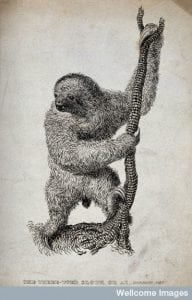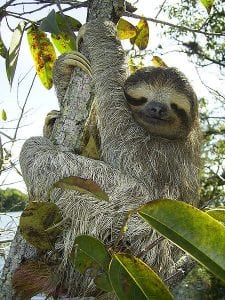One of my favourite letters in the Sloane Correspondence is a complaint from Charles Lennox, the 2nd Duke of Richmond (ca. 1729-1733).
Sr
I received your letter I am obliged to you
for it. I wish indeed it had been the sloath that
had been sent me, for that is the most curious
animal I know; butt this is nothing butt a
comon young black bear, which I do not know what
to do with, for I have five of them already. so pray
when you write to him, I beg you would tell
him not to send me any Bears, Eagles, Leopards,
or Tygers, for I am overstock’d with them already.I am Dear Sir,
Your Faithfull
humble servant
Richmond.(BL Sloane 4078, f. 66, undated)

A three-toed sloth or ai (Bradypus tridactylus). Etching by J(?) L., 1825. Image Credit: Wellcome Library, London.
Richmond established a well-known menagerie at Goodwood House, Sussex–though it was less famous than his son’s, which included more than one funny-looking Canadian moose. (If you’re interested in the Richmond family’s moose, as immortalized by artist George Stubbs, see Lisa Vargo’s article!)
The Richmond menagerie was by no means unique in Georgian England; the ability to import creatures from across the world expanded rapidly alongside British imperial ambition. Most famous, of course, was the Royal Menagerie at the Tower of London, which had been around since the thirteenth century and lasted until the 1830s. But across the country, aristocrats kept a wide array of exotic birds and animals by the eighteenth century. For the wealthy, such animal collections revealed their wealth, imperial connections and interests in natural history.
Hans Sloane himself collected living (and dead animals) while he lived in Bloomsbury, as Arnold Hunt reveals over at Untold Lives. As early as 1697, Sloane’s animals were attracting attention. Edward Tyson wrote to Sloane in February after hearing that Sloane’s possum had died. Tyson planned to dissect the animal the next day and wondered if Sloane would join him. In particular, he hoped that Sloane would do some research into what authors had written about possum anatomy. That Sloane’s collection was as likely to include weird pigs and cats as exotic beasts, suggests that his primary interest was to understand and to classify the natural world.
The fascination with strange beasts extended throughout society, with touring menageries able to attract large audiences. In Man and the Natural World (1983), Keith Thomas recounts a sad case of an elephant that died in 1720 after being exhibited in London, likely made ill by the spectators giving the elephant too much ale to drink. The keepers of travelling menageries, no doubt, were primarily driven by profit. The public interest in the menageries highlights both people’s desire to be entertained and a real curiosity in the natural world beyond Britain.

Three-toed-sloth (Bradypus variegatus), Lake Gatun, Republic of Panama. Image credit: Wikimedia Commons, Stefen Laube.
What of the Duke of Richmond’s motivations for establishing a menagerie, then? The Duke of Richmond’s letter tells us that he was a discerning collector. After acquiring a basic range of powerful creatures that represented the many parts of the globe, Richmond now wanted the more unusual animals. A sloth, for example, would be ideal, being “the most curious creature I know”. Curiosity was clearly a driving factor for him.
The letter leaves me to wonder what the Duke did with his surplus bears (…and eagles, leopards and tigers), especially given the recent culls at Copenhagen Zoo. Richmond’s description of being “overstock’d” might actually indicate that he kept the animals around. His collection, then, was also about acquisition: six bears might be a bit much, but some duplication was no bad thing. Despite his disappointment in Bear No. 6, the Duke may also have had affection for his unusual pets—shortly before his own death, he had a beloved lioness commemorated in statue-form!
Collecting animals was not an easy task. A collector might have money and connections, as Richmond did, but that didn’t guarantee that the most-desired animals would arrive. For the Duke’s sake, I hope that the mysterious “he” mentioned in the letter did manage to send back a sloth—because, really, who wouldn’t be charmed by this smiley fellow (or 200 of them)?
This summer, Goodwood House will be holding an exhibition on the Richmond family’s natural history collections.
